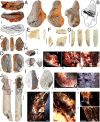Early human symbolic behavior in the Late Pleistocene of Wallacea
- PMID: 28373568
- PMCID: PMC5402422
- DOI: 10.1073/pnas.1619013114
Early human symbolic behavior in the Late Pleistocene of Wallacea
Abstract
Wallacea, the zone of oceanic islands separating the continental regions of Southeast Asia and Australia, has yielded sparse evidence for the symbolic culture of early modern humans. Here we report evidence for symbolic activity 30,000-22,000 y ago at Leang Bulu Bettue, a cave and rock-shelter site on the Wallacean island of Sulawesi. We describe hitherto undocumented practices of personal ornamentation and portable art, alongside evidence for pigment processing and use in deposits that are the same age as dated rock art in the surrounding karst region. Previously, assemblages of multiple and diverse types of Pleistocene "symbolic" artifacts were entirely unknown from this region. The Leang Bulu Bettue assemblage provides insight into the complexity and diversification of modern human culture during a key period in the global dispersal of our species. It also shows that early inhabitants of Sulawesi fashioned ornaments from body parts of endemic animals, suggesting modern humans integrated exotic faunas and other novel resources into their symbolic world as they colonized the biogeographically unique regions southeast of continental Eurasia.
Keywords: Pleistocene art; Pleistocene symbolism; Wallacea; cognition; personal ornamentation.
Conflict of interest statement
The authors declare no conflict of interest.
Figures




References
-
- Lohman DJ, et al. Biogeography of the Indo-Australian archipelago. Annu Rev Ecol Evol Syst. 2011;42:2015–2226.
-
- O’Connell JF, Allen J. The process, biotic impact, and global implications of the human colonization of Sahul about 47,000 years ago. J Archaeol Sci. 2015;56:73–84.
-
- Clarkson C, et al. The archaeology, chronology and stratigraphy of Madjedbebe (Malakunanja II): A site in northern Australia with early occupation. J Hum Evol. 2015;83:46–64. - PubMed
-
- Kealy S, Louys J, O’Connor S. Islands under the sea: A review of early modern human dispersal routes and migration hypotheses through Wallacea. J Island Coast Archaeol. 2015;11:364–384.
-
- O’Connell JF, Allen J. The restaurant at the end of the universe: Modeling the colonisation of Sahul. Aust Archaeol. 2012;74:5–31.
Publication types
MeSH terms
LinkOut - more resources
Full Text Sources
Other Literature Sources

